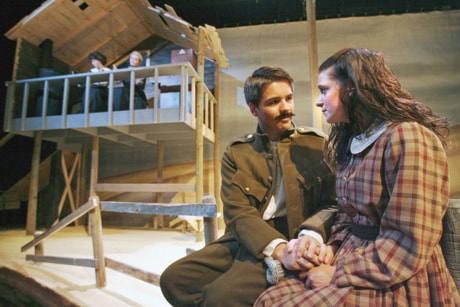Instructional posters about proper hand-washing techniques and how to cough and avoid spreading the H1N1 flu virus seem about as useful to Tanya Ryga as the hide-under-your-desk drills she went through as a elementary student during the Cold War.
But she acknowledged that potential victims of the deadly Spanish flu epidemic could probably have used a few more precautions in 1918.
“All they had was a few cotton masks and cloths to mop some foreheads. Otherwise, they just waited for it to come.”
When the Spanish flu did arrive — spread to even isolated communities by returning soldiers — it claimed more global victims than the First World War.
The first RDC Theatre Studies play of the season, Unity (1918), is about this under-told chapter of Canadian history — when the war was winding down and the flu was beginning to circulate.
“Whole towns were decimated — absolutely decimated. Whole families were dying,” said Ryga, who is directing the Governor General’s Award-winning epic that opens on Thursday in Studio A of the RDC Arts Centre.
Yet amid the play’s depicted devastation, the drama by Vancouverite Kevin Kerr manages to be darkly funny, in a death-is-part-of-life kind of way.
“Right when you feel your heartstrings are bursting, something oblique will happen and you will find yourself laughing, or your jaw dropping,” said Ryga, who loves the play’s quirky mood. “It’s not depressing at all,” she added, comparing it to a gentle rain that will “leave you feeling glad to be alive.”
The setting of the play is Unity, Sask. The action is narrated by a naive farm girl named Beatrice through daily jottings in her diary.
Bea longs for the return of her crush, a soldier named Glen, whom she hopes to marry after the war. Her feverish yearnings are evident in her journal descriptions of sexy dreams!
Bea and her sisters can’t wait for life to return to normal — but soon learn there are different kinds of normalcy.
“Any dreams of youth, love and romance are just evaporating in light of this reality,” said Ryga.
One of the first people to die is the town’s mortician, leaving the business to his dutiful teenage niece, Sunna.
Predictably, the flu brings out the best and worst in people: The Iceland-born Sunna soon has more business than she can handle, leaving some short-sighted townfolk grumbling about how she’s the only one benefitting from the scourge.
The town’s telephone and telegraph operators become “empresses of information,” and use their power to humorous effect, said Ryga.
Meanwhile, Bea’s sister Sissy begins spewing apocalyptic prophesies about The End of Days, while Bea becomes a self-appointed nurse, going from house to house to help the sick and dying after the town’s doctor succumbs to the flu.
The arrival of a blind soldier makes people fearful, wondering if he’s bringing more germs.
“People have to grow up fast. There’s no luxury of being an adolescent,” said Ryga, who loves the range of “wonderful” characters Kerr has created in Unity (1918).
Not only are they believable, they are mostly youthful and plucky — which makes them perfect roles for theatre students.
Her young cast members, “who only know Twitter and texting,” had fun making sense of a 1911 switchboard that was borrowed for the production from the museum, said Ryga.
One of the biggest challenges was creating a prairie setting, but the breadth of Saskatchewan will be depicted by a low horizon and an endless row of telephone lines.
Unity (1918) runs from Oct. 7 to 16. Tickets to the 7:30 p.m. production are $19 ($16 students/seniors) from Ticketmaster.
lmichelin@www.reddeeradvocate.com
